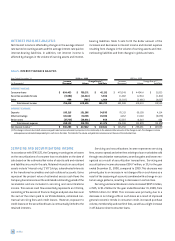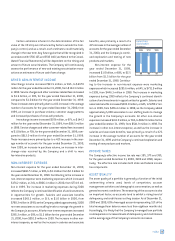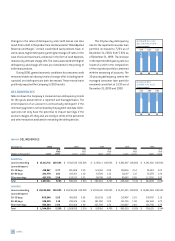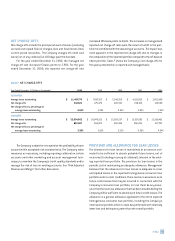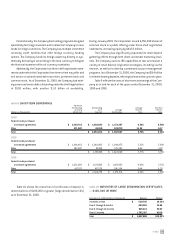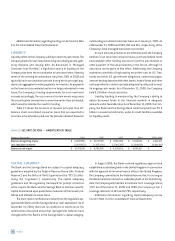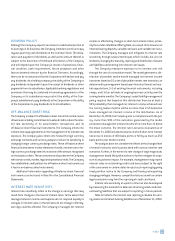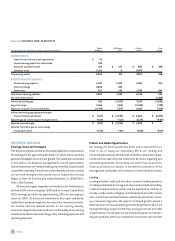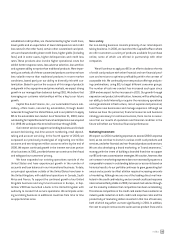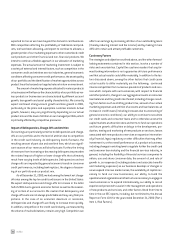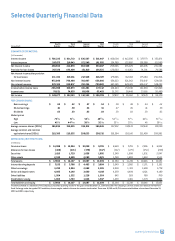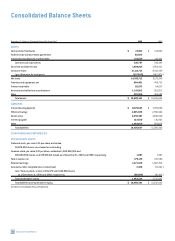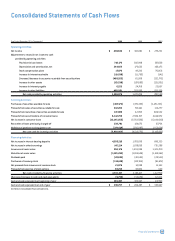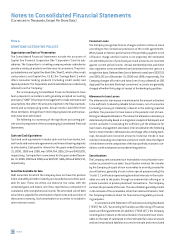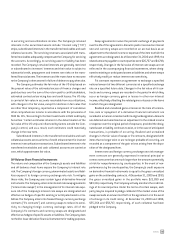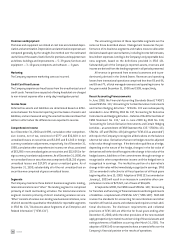Capital One 2000 Annual Report Download - page 42
Download and view the complete annual report
Please find page 42 of the 2000 Capital One annual report below. You can navigate through the pages in the report by either clicking on the pages listed below, or by using the keyword search tool below to find specific information within the annual report.
expected to rise as we move beyond the domestic card business.
With competition affecting the profitability of traditional card prod-
ucts, we have been allocating, and expect to continue to allocate, a
greater portion of our marketing expense to other customized credit
card products and other financial and non-financial products. We
intend to continue a flexible approach in our allocation of marketing
expenses. The actual amount of marketing investment is subject to
a variety of external and internal factors, such as competition in the
consumer credit and wireless service industries, general economic
conditions affecting consumer credit performance, the asset quality
of our portfolio and the identification of market opportunities across
product lines that exceed our targeted rates of return on investment.
The amount of marketing expense allocated to various products
or businesses will influence the characteristics of our portfolio as var-
ious products or businesses are characterized by different account
growth, loan growth and asset quality characteristics. We currently
expect continued strong account growth and loan growth in 2001,
particularly in the prime and superprime customer markets. Actual
growth, however, may vary significantly depending on our actual
product mix and the level of attrition in our managed portfolio, which
is primarily affected by competitive pressures.
Impact of Delinquencies, Charge-Offs and Attrition
Our earnings are particularly sensitive to delinquencies and charge-
offs on our portfolio and to the level of attrition due to competition
in the credit card industry. As delinquency levels fluctuate, the
resulting amount of past due and overlimit fees, which are signifi-
cant sources of our revenue, will also fluctuate. Further, the timing
of revenues from increasing or decreasing delinquencies precedes
the related impact of higher or lower charge-offs that ultimately
result from varying levels of delinquencies. Delinquencies and net
charge-offs are impacted by general economic trends in consumer
credit performance, including bankruptcies, the degree of season-
ing of our portfolio and our product mix.
As of December 31, 2000, we had among the lowest net charge-
off rates among the top ten credit card issuers in the United States.
We expect delinquencies and charge-offs to increase in the latter
half of 2001 due to general economic factors as well as the season-
ing of certain of our accounts. We caution that delinquency and
charge-off levels are not always predictable and may vary from pro-
jections. In the case of an economic downturn or recession,
delinquencies and charge-offs are likely to increase more quickly.
In addition, competition in the credit card industry, as measured by
the volume of mail solicitations, remains very high. Competition can
affect our earnings by increasing attrition of our outstanding loans
(thereby reducing interest and fee income) and by making it more
difficult to retain and attract profitable customers.
Cautionary Factors
The strategies and objectives outlined above, and the other forward-
looking statements contained in this section, involve a number of
risks and uncertainties. Capital One cautions readers that any for-
ward-looking information is not a guarantee of future performance
and that actual results could differ materially. In addition to the fac-
tors discussed above, among the other factors that could cause
actual results to differ materially are the following: continued
intense competition from numerous providers of products and serv-
ices which compete with our businesses; with respect to financial
and other products, changes in our aggregate accounts or consumer
loan balances and the growth rate thereof, including changes result-
ing from factors such as shifting product mix, amount of our actual
marketing expenses and attrition of accounts and loan balances; an
increase in credit losses (including increases due to a worsening of
general economic conditions); our ability to continue to securitize
our credit cards and consumer loans and to otherwise access the
capital markets at attractive rates and terms to fund our operations
and future growth; difficulties or delays in the development, pro-
duction, testing and marketing of new products or services; losses
associated with new products or services or expansion internation-
ally; financial, legal, regulatory or other difficulties that may affect
investment in, or the overall performance of, a product or business,
including changes in existing laws to regulate further the credit card
and consumer loan industry and the financial services industry, in
general, including the flexibility of financial services companies to
obtain, use and share consumer data; the amount of, and rate of
growth in, our expenses (including salaries and associate benefits
and marketing expenses) as our business develops or changes or
as we expand into new market areas; the availability of capital nec-
essary to fund our new businesses; our ability to build the
operational and organizational infrastructure necessary to engage in
new businesses or to expand internationally; our ability to recruit
experienced personnel to assist in the management and operations
of new products and services; and other factors listed from time to
time in the our SEC reports, including, but not limited to, the Annual
Report on Form 10-K for the year ended December 31, 2000 (Part I,
Item 1, Risk Factors).
40 md&a


